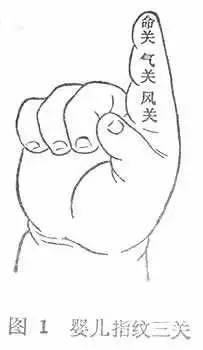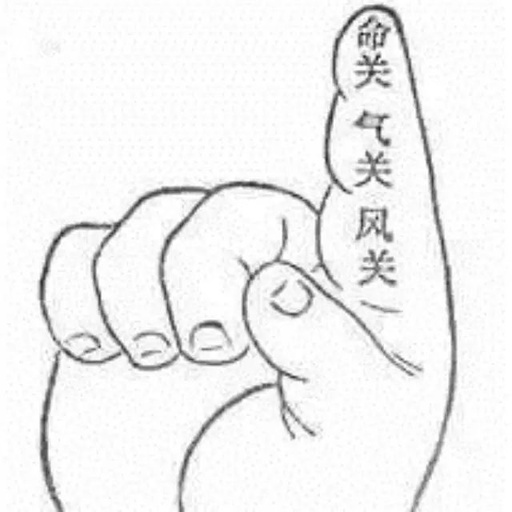
Fingerprints are the vascular patterns that appear on the palmar side of the index fingers of children. The method of diagnosing diseases by observing the changes in the shape and color of children’s fingerprints is called “fingerprint diagnosis” and is applicable only to children under three years old. Fingerprints are a branch of the Taiyin Lung Meridian (手太阴肺经), thus their diagnostic significance is similar to that of the pulse at the cun (寸口) position.
Fingerprints are divided into three sections: “Wind” (风), “Qi” (气), and “Life” (命). The first section near the palm of the index finger is the “Wind section,” the second section is the “Qi section,” and the third section is the “Life section.”
Children’s fingerprints
(1) Method of observing fingerprints
Hold the child in a well-lit area, with the physician using the left hand’s index finger and thumb to grasp the tip of the child’s index finger. With the right hand’s thumb, gently push along the palmar side of the index finger from the Life section towards the Qi section and Wind section several times, applying appropriate pressure to make the fingerprints more visible for observation.
(2) Clinical significance of observing fingerprints
Normal fingerprints show a light red to purplish color, subtly hidden within the Wind section, often not protruding or being very obvious, typically appearing slanted, single-branched, and of moderate thickness.
1. Changes in fingerprint position—— Assessing severity through the three sections: The position of the fingerprint refers to where it appears on the finger.
Based on the position of the fingerprint in the three sections of the finger, one can assess the depth of pathogenic factors and the severity of the condition. If the fingerprint is prominent near the Wind section, it indicates a superficial pathogen and a mild condition; if it extends from the Wind section to the Qi section, it indicates a deeper pathogen and a more severe condition; if it reaches from the Qi section to the Life section, it signifies a deep-seated illness; if the fingerprint extends through all three sections to the tip of the nail, it is referred to as “penetrating the sections and reaching the nail,” indicating a critical condition.
2. Changes in fingerprint color—— Differentiating cold and heat through color: The changes in fingerprint color mainly include red, purple, blue, black, and pale purple.
Bright red fingerprints often indicate an exterior wind-cold condition. Purple-red fingerprints are typically associated with heat syndromes. Blue fingerprints suggest wind or pain syndromes; blue-purple or black-purple colors indicate blood stasis; pale white fingerprints are often related to spleen deficiency.
3. Changes in fingerprint shape—— Differentiating superficial and deep conditions, and assessing deficiency and excess: The shape of the fingerprint refers to its depth, fineness, and thickness.
If the fingerprints are prominent and floating, it indicates a superficial condition; if they are hidden and not prominent, it indicates a deep condition. Fine and light-colored fingerprints are often associated with deficiency syndromes; coarse and dark fingerprints are typically indicative of excess syndromes.
In summary, the key points in observing children’s fingerprints are:
Distinguishing superficial and deep conditions, differentiating cold and heat through color;
Assessing deficiency and excess, and measuring severity through the three sections;
Considering the shape and color together, and observing carefully.
Everyone is looking at
-
Starting today, the price of high-speed rail tickets will be determined by the railway authorities!
-
Follow President Xi to see the media: Applauding national journalists
-
【Knowledge Expansion】Are Yuanxiao and Tangyuan just different names? They are fundamentally different!
Editor of this issue: Zhang Qishun Editor: Chen Chen
Source: WeChat public account “Zhongjing TCM Culture Communication”

Long press the QR code on the right
CCTV official account @ Network News Broadcast


